-
Engine4.6L V8, 115 kW, 95 kW
-
Power887 HP / 940 LB-FT
-
Transmission7-Speed DCT
-
0-60 Time2.5 Seconds
-
Top Speed214 MPH
-
DrivetrainAll-Wheel Drive
-
Curb Weight3,690 LBS
-
Seating2
-
MPGTBD
-
Base Price$845,000
-
As Tested Price$953,000 (est.)
Fifteen minutes later, I'm skeptically pondering that admonishment as I strap into the carbon-fiber tub of the Porsche 918 Spyder, the German automaker's latest supercar. With even a cursory glance, the two-seat, gasoline-electric hybrid, with a total output of nearly 900 horsepower, looks to be a masterpiece of engineering that qualifies it as not only the most sophisticated machine Porsche has ever built, but also its quickest and fastest road car of all time.
But that doesn't change the fact that I'm an amateur driving an all-new car on an unfamiliar European racing circuit. I silently chuckle at the request to avoid passing accomplished racer Timo Kluck in the company's flagship 911 sports car – all things considered, the warning seems a bit absurd.
Yet after just four laps, as I shatter 156 miles per hour down the front straight, I find myself running up his Turbo's tailpipes.

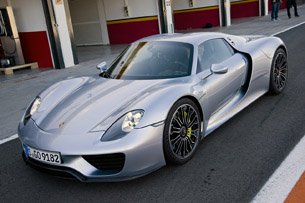
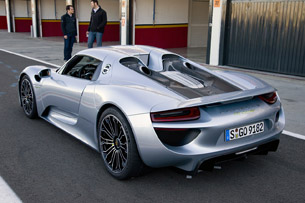
Porsche introduced its 918 Spyder Concept at the Geneva Motor Show in 2010. The sleek, 700-horsepower gasoline-electric hybrid showcar pushed all of the proper enthusiast buttons and quickly garnered overwhelming public approval – the company's supervisory board approved production shortly thereafter. Just two short years later, I traveled to Germany for an in-depth look and a ride along in an early test mule for our detailed Deep Dive: 918 Spyder report. The prototype was just 70-percent done, but encouragingly, its styling had been locked in place and its combined power had been bumped to 795 horsepower. After a spirited jaunt across the German countryside, a ride that ended far too soon, I yearned for some time behind its three-spoke steering wheel.Stuttgart has made more than a few tweaks to the 918 Spyder in the past 14 months.
I had to wait another full year for the opportunity to drive one myself, but my turn finally came last week at Spain's Circuit de la Comunitat Valencia Ricardo Tormo (better known as Circuit de Valencia). The 2.5-mile racetrack hosts MotoGP and serves as a winter testing ground for Formula One. Of course, in early December, the bikes and open-cockpit cars were nowhere to be found. Instead, pit lane was choked with a half-dozen early production Porsche 918 Spyders, and I stood holding the keys to the only example hand-sprayed in $63,000-worth of Liquid Metal Chrome Blue paint.
Stuttgart has made more than a few tweaks to the 918 Spyder in the past 14 months. While the majority of the work has involved rewriting algorithms and lines of computer code to polish the operation of more than 55 different control units, dozens of electric motors and four primary black boxes, some mechanical enhancements were called for, too.
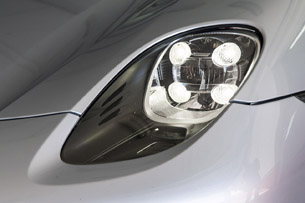
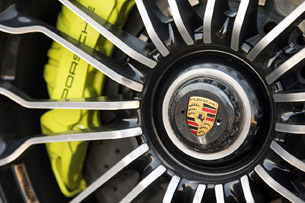
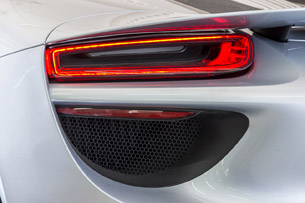
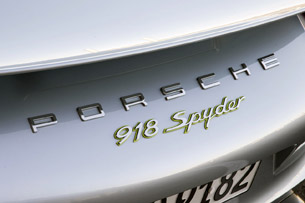
The 90-degree, 4.6-liter dry-sump V8 that's mid-mounted in the 918's carbon fiber-reinforced plastic (CFRP) monocoque chassis has been further refined to deliver 608 horsepower on its own. The electric motor directly behind it, sandwiched between the engine and Porsche's seven-speed dual-clutch PDK gearbox, is now rated at 115 kW (154 horsepower) and the electric motor in the nose tasked with driving the front wheels has been tweaked to provide 95 kW (127 horsepower). All told, total system power has jumped by 92 horses for a new, astonishing rating of 887 horsepower. Leave your jaw on the table, as the production-ready powertrain also generates an obscene amount of torque – a mind-blowing 940 pound-feet.
Overall mass has dropped too. Even with a 304-pound, 6.8-kWh lithium-ion traction battery pack on board, nestled low and in the middle of the chassis, the all-wheel-drive 918 Spyder has a curb weight of 3,690 pounds (the car's center of gravity is at the height of the wheel hub, with its weight distributed 43 percent over the front axle and 57 percent over the rear).Porsche conservatively says the top-spec Weissach model will hit 62 mph in 2.6 seconds.
As expected, the 918 Spyder's performance is phenomenal. Porsche conservatively says the top-spec Weissach model will hit 62 mph in 2.6 seconds, 124 mph in 7.2 seconds and 186 mph in 19.9 seconds from a standstill. The vehicle's top speed in electric-only mode is 93 mph, but the Porsche will push to 214 mph with its engine lit. The car recently lapped Nürburgring in a blistering 6:57, setting a new record for a production vehicle on stock tires.
But Circuit de Valencia isn't the Nordschleife, and quite frankly, I'm not wearing a firesuit.
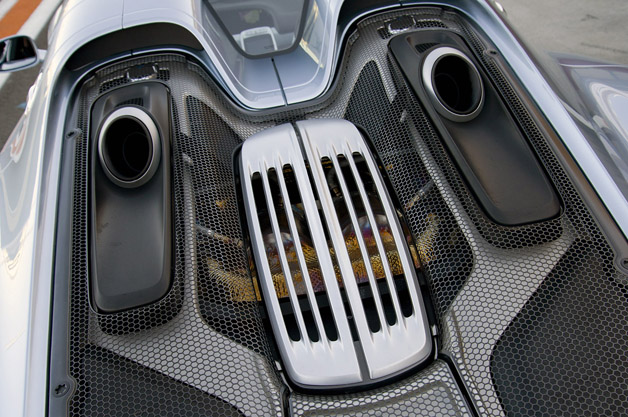
Face-to-face with the 918, the automaker's new flagship has strong stage presence. The Spyder is low, wide and long (compared to the Chevrolet Corvette Stingray, a familiar American icon, the Porsche's height is nearly three-inches shorter, its shoulders are three-inches wider and it is about five-inches longer overall). Standing next to it, the two-piece carbon-fiber roof barely clears my belt buckle.
The doors open wide to reveal a carbon-fiber tub with thick sills. Although I expected lots of wiggling, dropping my six-foot, two-inch frame into the driver's seat wasn't a chore. The carbon-fiber sport bucket is fixed in rake, but it offers power height and manual sliding adjustments. I slid it all the way rearward and pulled the telescoping three-spoke steering wheel as close as I could. The driving position reminded me of a 911 GT3 Cup race car, with the wheel a bit further forward and higher than I would have liked, and the seat upright. Leg and headroom wasn't an issue, however.The 918 is started by inserting the nose of its sculpted key fob into a slot to the left of the steering wheel.
The 918 is started by inserting the nose of its sculpted key fob into a slot to the left of the steering wheel. After a half turn, the dashboard boots to life and a few electric motors start to whirr. Assuming there is any charge left in the battery, and there almost always will be, the gas engine will remain silent. To the right of the steering wheel on the face of the dashboard is a small knurled aluminum transmission lever (RND) sharing space with the electronic parking brake button. With a foot on the brake pedal, a short flick of the wrist moves the Porsche into Drive – but there's one more step.
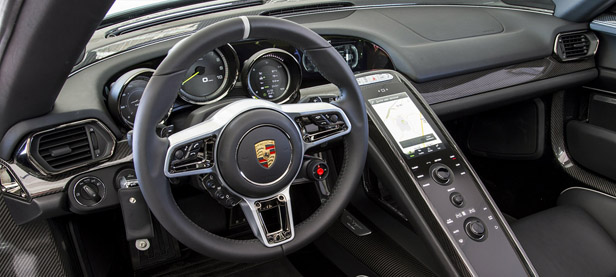
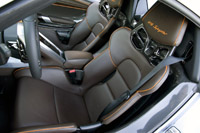
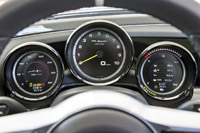
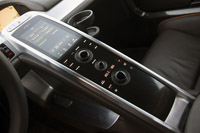
Just below the steering wheel's right spoke is a knurled rotary knob with four letters (EHSR) and a bright-red button in the middle. That seemingly insignificant dial is very important, as it's tasked with putting the 918's powertrain into one of five drive modes:
- E-Power – This default setting provides pure electric propulsion at speeds of up to 93 mph. A full charge will deliver a range of up to 18 miles.
- Hybrid – A setting to maximize fuel economy and range in which the combustion engine cycles to provide propulsion and charge the batteries.
- Sport Hybrid – For spirited on-road driving, the combustion engine runs continuously and provides primary propulsion. Battery charge is maintained at a set level. This mode is used for top speed runs.
- Race Hybrid – Useful for track driving. In this mode, the engine is fully utilized to propel the vehicle and excess combustion power is used to aggressively recharge the battery for additional electric boost. Fuel economy is a low priority.
- Hot Lap – Press the red button in Race Hybrid mode, and all combustion and electric resources are dedicated solely to provide maximum propulsion for a few fast laps. Since it is not being recharged, battery power is quickly drained.
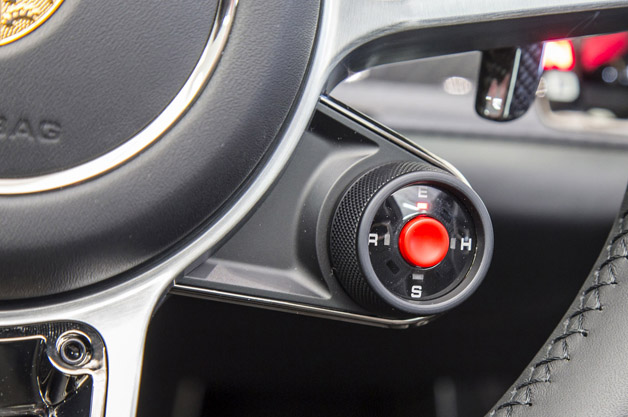
While waiting in the hot pits at Circuit de Valencia, I was instructed over the radio to leave the powertrain map switch in E (E-Power) until I had a few corners under my belt. Then I would switch to S (Sport Hybrid) and work my way through the other driving modes as each lap passed.
E-mode isn't designed to thrill, but the Porsche moved smartly off the line running purely on electrons all the same. I noted the whirring of the drive motor and the brushing noise of the carbon-ceramic brake rotors against their pads, but the coupe was near-silent otherwise. Porsche says in this EV mode, the 918 will do 0-60 in under seven seconds, but pressing the accelerator through its artificial kickdown or pulling the left wheel-mounted shift paddle will fire up the V8 instantaneously. The automaker ensures that there is no vulnerability running the 918 in E-Power, with the engine constantly poised like a wind-up jack-in-the-box one note from release.Porsche says in EV mode, the 918 will do 0-60 in under seven seconds.
Despite its physical size and burly stance, the 918 Spyder felt small and agile from behind the wheel. Forward visibility was good, its 911-ish fender bulges helping with precise wheel placement. Visibility was near non-existent rearward, however, as only a small trapezoid window offers any view of the world behind. I relied mostly on the exterior mirrors, which were much more effective, along with a low-mounted backup camera.
After two quick corners with the electric motors whining and speeds of no greater than 45 mph, I rotated the dial to S and the combustion engine barked to life. Its arrival was heard, seen and felt as an excited roar broke out, shattering the silence, with the prominent center-mounted tachometer springing to life as my seat began to vibrate. I expected a surge in power or some other accelerative sign that 608 horsepower had awakened, but as my right foot had not moved the accelerator pedal a millimeter, nothing changed.
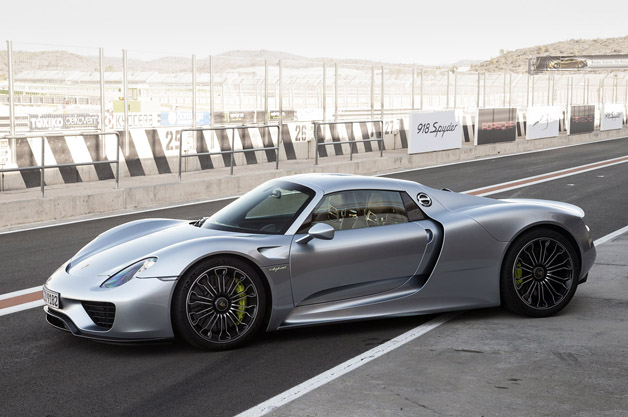
The perfectly manicured track was wide open except for a lone 911 Turbo S being piloted by Timo Kluck (the factory driver currently holds the Nürburgring record for a stock 991 Carrera S). My instruction was to stay close on his tail but not pass, so he could show me the line. His car was getting smaller in the sloped windshield, so I pressed the accelerator with authority.
The resulting throttle response was as explosive as dropping a cube of potassium in a glass of water – the 918 shot forward and the chase was on.
Accelerating out of the first corner, the 918 squirmed ever so slightly and then blasted down the track. I pushed harder on the accelerator, prodding it just to test its response. The V8 climbed rapidly through 5,500 rpm and its pitch turned to a screaming wail. The short titanium exhaust pipes, exiting upward just a few feet aft of my ears, howled like a full-blown racecar. Pinned firmly against my seatback with the engine hovering just below redline, I giddily cursed with the dialect of a sailor.The short titanium exhaust pipes, exiting upward just a few feet aft of my ears, howled like a full-blown race car.
The 918 was moving at a good clip, and I was carrying far too much speed for the next right hander, so I aggressively stabbed the brake pedal. Porsche has engineered the hybrid braking system to use only regenerative braking until more than 0.5 G of braking is required. This means the calipers are in standby mode, only along for the ride, until they are instantly called to duty at 0.51 G or more of braking force. The synchronized mastery required to create a seamless transition between the deceleration rate and pedal feel is monumental – but Porsche's engineers seem to have pulled it off. Initial bite was reassuring, and the 918 hunkered down and bled off 50 mph without any unexpected drama.
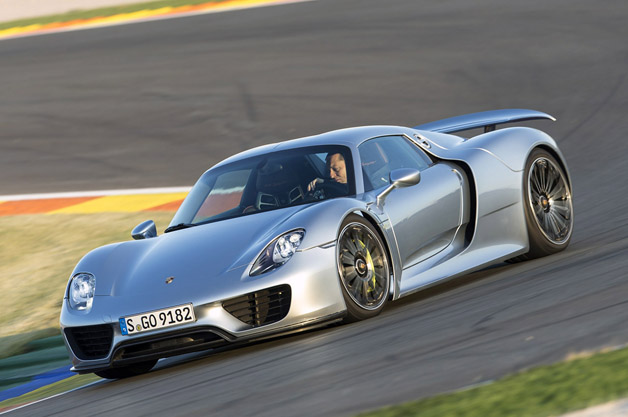
Diving into the unfamiliar corner, I took mental note of how balanced the chassis felt. Without any perceptible body roll and an asphalt-hugging low center of gravity, the 918 Spyder felt planted and my confidence level soared. Before the drive, I had worried about steering feel. Yet the electro-mechanical system was nicely weighted and very accurate. In fact, I didn't have any trouble putting the shoulders of the sticky Michelin Pilot Sport Cup 2 tires right on the edge of the circuit's brightly painted curbs. Overall, I would describe the handling as mid-engine neutral with excellent transitional balance and remarkable stability. A 918 Spyder is a lightning-fast, hybrid-powered slot car.
After experimenting with several settings, I decided that R (Race Hybrid) would be my preferred setting on the track. In this configuration, the PDK was in its most aggressive setting, meaning up- and downshifts were neck-snappingly brutal, active aerodynamics were configured for maximum downforce and all of the engine's power was being directed to either drive the rear wheels or keep the battery pack charged.A 918 Spyder is a lightning-fast hybrid-powered slot car.
As it turns out, the 918 Spyder is surprisingly easy to drive at blistering speeds, and its library of electronic aids accomplishes everything short of rewriting the established laws of physics. Porsche Torque Vectoring Plus (PTV Plus) provides additional turn-in during spirited driving, active rear steering improves turn-in and stability and Porsche Active Suspension Management (PASM) ensures that the staggered wheels are always in contact with the pavement. I deliberately chose not to think about the sophisticated subsystems that were making me look good – instead, I chose to take advantage of them.
Kluck may be a better driver, but on this day, I had the much better car. While his racing talent and fearlessness carried him more quickly through the twisty corners, my club racer mindset realized that if I exercised the Spyder's stronger braking, better lateral grip and much more powerful acceleration, I'd be able to even the score. I was soon diving deeper into each corner and getting on the throttle earlier. Throwing horsepower at the equation and letting the electronically controlled all-wheel-drive system find the grip was the simplest way to gain ground.
During one of my later trips around the circuit, with the vehicle mapped on its most aggressive Hot Lap setting, I buried the throttle on the long straight. My eyesight became blurry as 887 horsepower and 940 pound-feet of torque flattened my hair against the seat. Moments later when I glanced down and caught the speedometer rolling past 150 mph, I had to abruptly lift off the throttle to keep from running into the rear valance of the Turbo S – it is wickedly quick, and drama-free. The 918 is so effortless to drive fast and forgiving at the limit that I'm quite sure it's is going to allow its owners to set multiple new records at their local tracks.My eyesight became blurry as 887 horsepower and 940 pound-feet of torque flattened my hair against the seat.
After a coffee break, I jumped into a 918 with the optional Weissach Package (the white car with the Salzburg racing stripes below). For $84,000 over the standard model's $845,000 base price, buyers get a handful of enhancements, including beautiful ultra-lightweight magnesium wheels that cut weight by 90 pounds while improving aerodynamics. Even though the slightly less luxurious cabin may turn a few away (much of the interior's leather is replaced with Alcantara or hard carbon fiber), I noticed a definite performance improvement on the track. The upgraded coupe felt more agile and lighter in the corners, and braking seemed keener.
Furthermore, the increased noise level of the engine heightened the driving experience. If I were an owner, I'd step up to the Weissach Package just so I didn't have to explain to gawkers at Cars & Coffee why my 918 didn't have it.
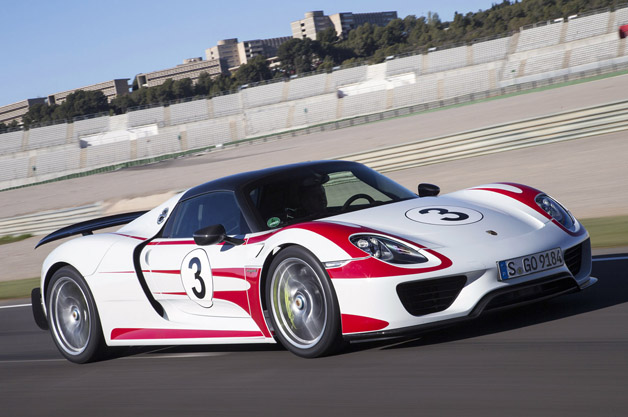
Thankfully, I didn't just drive Porsche's newest offering on the track. After a full morning on the circuit, the exotics were lined up for an escorted drive on the public roads through Valencia. The weather was nice, so I took the opportunity to drive with the two-piece Targa roof stored in the front trunk, which effectively ate up every bit of luggage space. With speeds mostly following the posted limits, the urban drive offered everyone a nice opportunity to run in electric mode for an extended period, experience the electric-to-combustion transitions and focus on the 918's real-world suspension tuning.
I was surprised to find enjoyment with the E-Power mapping, as an all-electric supercar doesn't sound initially appealing. Yet, the 918 was enjoyable. As mentioned, the electric motors provide brisk acceleration and near-silent running at freeway speeds and faster. Passers-by noticed the new Porsche, and it was humorous to watch their faces as I glided silently past. With the top off and windows down, I couldn't shake comparative thoughts to the anti-gravity Star Wars Landspeeder. A firm suspension reminded me that the 918 was not floating on air, but its ride was never harsh over even the most broken concrete. I drove in this combustion-free green mode for about 15 minutes before the boy in me spun the engine's map selector to fire up the V8, an action that instantly cut its 0-60 sprint by nearly two-thirds.The boy in me spun the engine's map selector to fire up the V8, an action that instantly cut its 0-60 sprint by nearly two-thirds.
Using Race Hybrid mode on public streets is a bit ludicrous, but wonderfully fun. The combustion engine with one of the world's shortest exhaust passages is obnoxiously loud and boastful when the roof is off, and its unique racing note turns heads on both sides of the sidewalk (especially when the engine is adolescently revved to 8,500 rpm in neutral to the cheers of schoolchildren). Throttle response from the V8 is immediate, and knifing the agile combustion-powered supercar through traffic is effortless thanks to four-wheel steering and an abundance of low-end torque.
Public civility is just a quarter turn of the rotary knob away. When spun, the combustion engine extinguished immediately and the 918 Spyder again resumed its silent glide and impressive fuel efficiency (the 918 earned a very impressive 3.0 l/100 km in the NEDC, but Porsche will wait for the EPA to release numbers for the States). It is this dual personality with such polar extremes on the performance scale that best encapsulates Porsche's 918 engineering superiority.
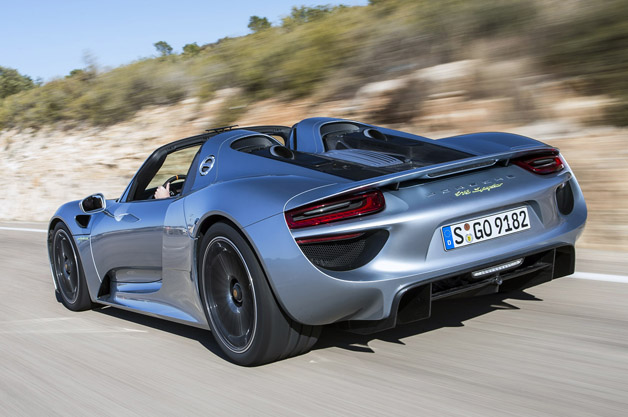
While I initially found it interesting that Porsche made no mention of the Ferrari LaFerrari, Lamborghini Veneno or McLaren P1 during our time with its 918 Spyder – most enthusiasts consider all four vehement enemies of each other, as their performance envelopes are similar – the more I drove the Porsche and studied its history and engineering, the less I tossed them into the same ring.Porsche has again introduced a super sports car that strives for the highest level of technical superiority.
Each decade for the past 60 years, Porsche has introduced a special range-topping sports car that has paved innovative new ground for its future models. Its most significant recent contribution was the 1985 Porsche 959, an all-wheel drive, twin-turbocharged, Kevlar-bodied coupe that was at the time the most technologically advanced street car ever built. In an era when the Lamborghini Countach and Ferrari F40 were focusing on expanding the automobile's performance envelope, Porsche was expanding the boundaries of automotive engineering.
Today, as its competitors continue the battle for performance supremacy, Porsche has again introduced a super sports car that strives for the highest level of technical superiority. Not only is the new carbon-fiber hybrid every bit as historically significant as the 959 that paved its path, it is an advanced look at the excitement of automotive transportation for the next decade or more. As I said 14 months ago, the 918 Spyder is the future – today.


















Sign in to post
Please sign in to leave a comment.
Continue